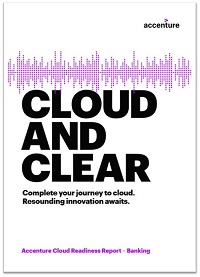Guest blogger Kamran Ikram examines why a phased and layered approach is the best way for banks to migrate to the cloud.
Moving to the cloud has the potential to bring huge benefits for banks. To name but a few, these include lower cost of operations, higher agility, faster speed to market and unprecedented scalability.
An important driver of all these benefits is the automation that cloud providers have built into their solutions, thus removing the manual steps that exist in traditional IT processes. A key challenge for all organisations is how to take full advantage of these new capabilities, when they’ve spent millions—maybe billions—on building legacy applications that run in their own data centres.

Banking Cloud Altimeter | Volume 6: Banks need a flight plan to navigate the cloud.
LEARN MOREThis challenge is especially pressing for banks. Their typically mainframe-based core banking systems have been fine-tuned and finessed over decades to handle the core activities that their customers and regulators expect to work all of the time: direct debits, ATM withdrawals, credit and debit transactions and the like. Their core systems do these things very well and very reliably and it is headline news when they fail.
It’s become clear that what’s needed is a phased approach: one that involves leaving the core banking environment operating as-is for the medium-term.
So, how do banks harness the power of cloud for these core activities? Our recently launched cloud readiness report for banking finds that 94 percent of banks have conducted—or intend to conduct—formal planning and analysis of legacy applications for early migration to the cloud. But only one-third have developed a strategy for application modernisation for cloud.

This lack of strategic roadmaps underlines the scale of the challenge. Banks need to make the journey to the cloud, but can’t risk any disruption to their core banking systems. What’s more, any wholesale migration of core banking will be a multi-year and probably multi-billion-dollar undertaking.
In our work helping clients tackle these issues, it’s become clear that what’s needed is a phased approach: one that involves leaving the core banking environment operating as-is for the medium-term, while taking two key steps.
The first is “digital decoupling”. This means isolating the legacy core banking systems from the new digital capability using, for example, APIs, and realising the full power and benefits of the cloud in the digital portion—enabling banks to get up to digital speed in targeted customer offerings without risking their core transactional processes.
With the legacy and cloud components decoupled, banks are ready to begin the second step: “hollowing the core”. This involves using a layered approach to migrate specific applications and services from the core to cloud over time, deciding on a case-by-case basis whether to simply shift the legacy functionality across, rebuild it so it’s truly cloud-native, or move to a packaged software-as-a service (SaaS) solution.
The beauty of this approach is its combination of optionality and low risk. It enables banks to capitalise on the benefits of cloud and migrate functionality across at their own pace, while prioritising those activities where cloud will bring the biggest benefits to banks and their customers. As an example, balance enquiries on mobile devices could be migrated away from the mainframe onto read-only databases without impacting the core account management or transactional activities.
Indeed, banks may even choose to leave core transactions in legacy systems for the long term as a system of record. There’s no right or wrong answer: every bank’s approach to hollowing the core will be as unique as its own business and strategy.
Looking across and beyond financial services, we’ve all seen cases where organisations have gone for a “big bang” migration from legacy and hit problems. In banking, we believe the risks of such an approach can be managed for cloud migration by taking a “phased” and “layered” approach. That’s the best way to navigate your journey to the cloud.

Kamran Ikram
Managing Director, Financial Services











